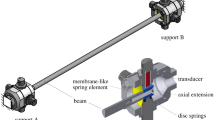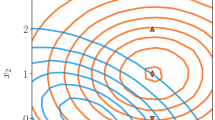Abstract
Estimation of surrogate models for computer experiments leads to nonparametric regression estimation problems without noise in the dependent variable. In this paper, we propose an empirical maximal deviation minimization principle to construct estimates in this context and analyze the rate of convergence of corresponding quantile estimates. As an application, we consider estimation of computer experiments with moderately high dimension by neural networks and show that here we can circumvent the so-called curse of dimensionality by imposing rather general assumptions on the structure of the regression function. The estimates are illustrated by applying them to simulated data and to a simulation model in mechanical engineering.


Similar content being viewed by others
References
Anthony, M., Bartlett, P. L. (1999). Neural networks and learning: Theoretical foundations. Cambridge: Cambridge University Press.
Barron, A. R. (1991). Complexity regularization with application to artificial neural networks. In G. Roussas (Ed.), Nonparametric functional estimation and related topics (pp. 561–576)., NATO ASI series Dordrecht: Kluwer Academic Publishers.
Barron, A. R. (1993). Universal approximation bounds for superpositions of a sigmoidal function. IEEE Transactions on Information Theory, 39, 930–944.
Beirlant, J., Györfi, L. (1998). On the asymptotic \({L}_2\)-error in partitioning regression estimation. Journal of Statistical Planning and Inference, 71, 93–107.
Bichon, B. J., Eldred, M. S., Swiler, L. P., Mahadevan, S., McFarland, J. M. (2008). Efficient global reliability analysis for nonlinear implicit performance functions. AIAA Journal, 46, 2459–2468.
Bourinet, J.-M., Deheeger, F., Lemaire, M. (2011). Assessing small failure probabilities by combined subset simulation and support vector machines. Structural Safety, 33, 343–353.
Bucher, C., Bourgund, U. (1990). A fast and efficient response surface approach for structural reliability problems. Structural Safety, 7, 57–66.
Das, P.-K., Zheng, Y. (2000). Cumulative formation of response surface and its use in reliability analysis. Probabilistic Engineering Mechanics, 15, 309–315.
Deheeger, F., Lemaire, M. (2010). Support vector machines for efficient subset simulations: \(^2\)SMART method. In: Proceedings of the 10th international conference on applications of statistics and probability in civil engineering (ICASP10), Tokyo, Japan.
Devroye, L. (1982). Necessary and sufficient conditions for the almost everywhere convergence of nearest neighbor regression function estimates. Zeitschrift für Wahrscheinlichkeitstheorie und verwandte Gebiete, 61, 467–481.
Devroye, L., Krzyżak, A. (1989). An equivalence theorem for \({L}_1\) convergence of the kernel regression estimate. Journal of Statistical Planning and Inference, 23, 71–82.
Devroye, L., Wagner, T. J. (1980). Distribution-free consistency results in nonparametric discrimination and regression function estimation. Annals of Statistics, 8, 231–239.
Devroye, L., Györfi, L., Krzyżak, A., Lugosi, G. (1994). On the strong universal consistency of nearest neighbor regression function estimates. Annals of Statistics, 22, 1371–1385.
Devroye, L., Györfi, L., Lugosi, G. (1996). A probabilistic theory of pattern recognition. New York: Springer.
Enss, G., Kohler, M., Krzyżak, A., Platz, R. (2016). Nonparametric quantile estimation based on surrogate models. IEEE Transactions on Information Theory, 62, 5727–5739.
Friedman, J. H., Stuetzle, W. (1981). Projection pursuit regression. Journal of the American Statistical Association, 76, 817–823.
Greblicki, W., Pawlak, M. (1985). Fourier and Hermite series estimates of regression functions. Annals of the Institute of Statistical Mathematics, 37, 443–454.
Györfi, L. (1981). Recent results on nonparametric regression estimate and multiple classification. Problems of Control and Information Theory, 10, 43–52.
Györfi, L., Kohler, M., Krzyżak, A., Walk, H. (2002). A distribution-free theory of nonparametric regression. Springer series in statistics. New York: Springer.
Hansmann, M., Kohler, M. (2017). Estimation of quantiles from data with additional measurement errors. Statistica Sinica, 27, 1661–1673.
Hastie, T., Tibshirani, R., Friedman, J. (2011). The elements of statistical learning: Data mining, inference, and prediction (2nd ed.). New York: Springer.
Haykin, S. O. (2008). Neural networks and learning machines (3rd ed.). New York: Prentice-Hall.
Hertz, J., Krogh, A., Palmer, R. G. (1991). Introduction to the theory of neural computation. Redwood City, CA: Addison-Wesley.
Hurtado, J. (2004). Structural reliability—Statistical learning perspectives. Vol. 17 of lecture notes in applied and computational mechanics. Berlin: Springer.
Kaymaz, I. (2005). Application of Kriging method to structural reliability problems. Structural Safety, 27, 133–151.
Kim, S.-H., Na, S.-W. (1997). Response surface method using vector projected sampling points. Structural Safety, 19, 3–19.
Kohler, M. (2000). Inequalities for uniform deviations of averages from expectations with applications to nonparametric regression. Journal of Statistical Planning and Inference, 89, 1–23.
Kohler, M. (2014). Optimal global rates of convergence for noiseless regression estimation problems with adaptively chosen design. Journal of Multivariate Analysis, 132, 197–208.
Kohler, M., Krzyżak, A. (2001). Nonparametric regression estimation using penalized least squares. IEEE Transactions on Information Theory, 47, 3054–3058.
Kohler, M., & Krzyżak, A. (2005). Adaptive regression estimation with multilayer feedforward neural networks. Journal of Nonparametric Statistics, 17, 891–913.
Kohler, M., Krzyżak, A. (2013). Optimal global rates of convergence for interpolation problems with random design. Statistics and Probability Letters, 83, 1871–1879.
Kohler, M., Krzyżak, A. (2017). Nonparametric regression based on hierarchical interaction models. IEEE Transaction on Information Theory, 63, 1620–1630.
Lazzaro, D., Montefusco, L. (2002). Radial basis functions for the multivariate interpolation of large scattered data sets. Journal of Computational and Applied Mathematics, 140, 521–536.
Lugosi, G., Zeger, K. (1995). Nonparametric estimation via empirical risk minimization. IEEE Transactions on Information Theory, 41, 677–687.
Massart, P. (1990). The tight constant in the Dvoretzky–Kiefer–Wolfowitz inequality. Annals of Probability, 18, 1269–1283.
McCaffrey, D. F., Gallant, A. R. (1994). Convergence rates for single hidden layer feedforward networks. Neural Networks, 7, 147–158.
Mhaskar, H. N. (1993). Approximation properties of multilayer feedforward artificial neural network. Advances in Computational Mathematics, 1, 61–80.
Mielniczuk, J., Tyrcha, J. (1993). Consistency of multilayer perceptron regression estimators. Neural Networks, 6, 1019–1022.
Nadaraya, E. A. (1964). On estimating regression. Theory of Probability and Its Applications, 9, 141–142.
Nadaraya, E. A. (1970). Remarks on nonparametric estimates for density functions and regression curves. Theory of Probability and Its Applications, 15, 134–137.
Papadrakakis, M., Lagaros, N. (2002). Reliability-based structural optimization using neural networks and Monte Carlo simulation. Computer Methods in Applied Mechanics and Engineering, 191, 3491–3507.
Rafajłowicz, E. (1987). Nonparametric orthogonal series estimators of regression: A class attaining the optimal convergence rate in L2. Statistics and Probability Letters, 5, 219–224.
Ripley, B. D. (2008). Pattern recognition and neural networks. Cambridge: Cambridge University Press.
Stone, C. J. (1977). Consistent nonparametric regression. Annals of Statististics, 5, 595–645.
Stone, C. J. (1982). Optimal global rates of convergence for nonparametric regression. Annals of Statistics, 10, 1040–1053.
Stone, C. J. (1985). Additive regression and other nonparametric models. Annals of Statistics, 13, 689–705.
Stone, C. J. (1994). The use of polynomial splines and their tensor products in multivariate function estimation. Annals of Statistics, 22, 118–184.
Wahba, G. (1990). Spline models for observational data. Philadelphia, PA: SIAM.
Watson, G. S. (1964). Smooth regression analysis. Sankhya Series A, 26, 359–372.
Acknowledgements
The first three authors would like to thank the German Research Foundation (DFG) for funding this project within the Collaborative Research Centre 805. The last author would like to thank the Natural Sciences and Engineering Research Council of Canada for additional support under Grant RGPIN-2015-06412.
Author information
Authors and Affiliations
Corresponding author
Electronic supplementary material
Below is the link to the electronic supplementary material.
About this article
Cite this article
Bauer, B., Heimrich, F., Kohler, M. et al. On estimation of surrogate models for multivariate computer experiments. Ann Inst Stat Math 71, 107–136 (2019). https://doi.org/10.1007/s10463-017-0627-8
Received:
Revised:
Published:
Issue Date:
DOI: https://doi.org/10.1007/s10463-017-0627-8




